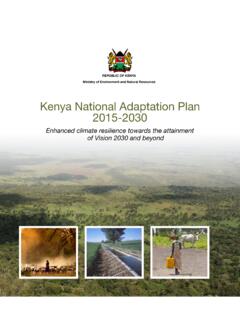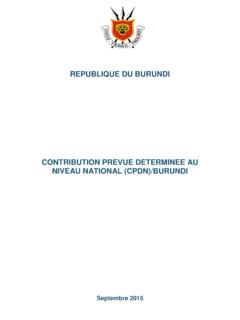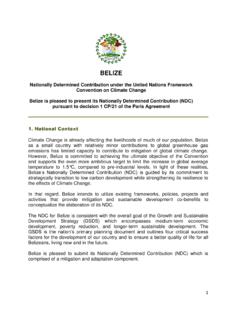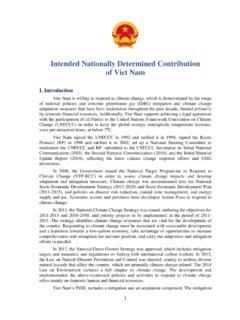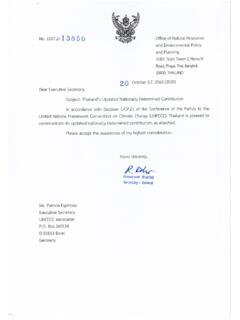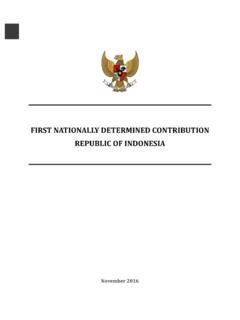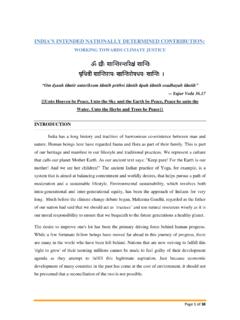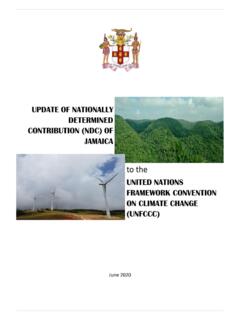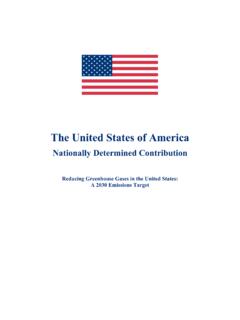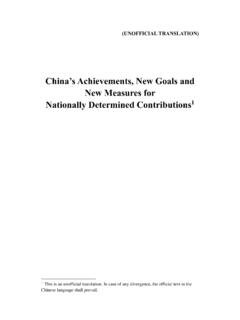Transcription of Republic of Fiji National Adaptation Plan - UNFCCC
1 Republic of Fiji National Adaptation Plan A pathway towards climate resilience Government of the Republic of Fiji, 2018. All rights for commercial/for profit reproduction or translation, in any form, reserved. Original text: English Document images: Istock Cover image: Ministry of Information, Government of the Republic of Fiji Illustrations: As specified This document was developed through the United States In-Country National Adaptation Plan (NAP) Support Program in Fiji, which is implemented by the International Institute for Sustainable Development (IISD), host to the NAP Global Network Secretariat. Any opinions stated herein are those of the author(s) and do not necessarily reflect the policies or opinions of the NAP Global Network, funders or Network participants. United States In-Country National Adaptation Plan (NAP) Support Program Gift of the United States Government Implemented by: Initial funding for the Network also provided by: Financial support provided by: Ce projet a t r alis avec l'appui financier de : Republic of Fiji National Adaptation Plan A pathway towards climate resilience Prepared by the Government of the Republic of Fiji, in consultation with National and Sub- National stakeholders with the support of the NAP Global Network.
2 Published by the Government of the Republic of Fiji Suva, Fiji, 2018. Republic of Fiji National Adaptation Plan iii Foreword The Fijian Government has created Fiji's first ever National Adaptation Plan ( NAP'), with support from the NAP Global Network, as its main overarching process for comprehensively addressing climate change. The NAP provides a clear vision for Adaptation and identifies priorities to be addressed in partnership with academic institutions, development partners, and private sector entities over the next five years, and beyond. It addresses vulnerabilities identified by the Climate Vulnerability Assessment, and adopts the values and principles of the NAP Framework. The NAP has been produced because climate change is already posing major risks to our economy, society, and way of life. It is not a future problem, but one which is already evident.
3 Unless global mitigation efforts increase, these risks will intensify to unprecedented levels. The new Inter-governmental Panel on Climate Change Global Warming of C' special report has stressed the importance of substantially increasing mitigation ambition to limit global temperature increase to C above pre-industrial levels. It is imperative that all nations rachet up their mitigation related Nationally Determined Contributions to achieve the goals of Paris Agreement to ensure that Small Island Developing States such as Fiji have an opportunity to adapt to climate change before it is too late. The NAP is built upon comprehensive stocktake and prioritisation processes. It functions as a strategic high-level action plan for Adaptation . It builds upon the existing policy and planning landscape, shifting development planning processes towards a pathway of climate-resilience'.
4 This NAP development process has been an inter-Ministerial affair with facilitation and coordination provided by the Climate Change and International Cooperation Division of the Ministry of Economy. Fourteen multi-stakeholder technical working groups comprised of private sector, civil society, academic, as well as National and sub- National Government representatives guided the development of its high-level strategic actions. The manner in which it has been developed has been designed to ensure technical, institutional, and stakeholder legitimacy. The creation of the NAP is the latest initiative by the Fijian Government in its quest to boost the resilience of the Fijian economy and of all Fijians. The Fijian Government is doing its part; however, it needs international support to ensure that the NAP is fully implemented. Hon. Aiyaz Sayed-Khaiyum Attorney-General and Minister responsible for climate change Republic of Fiji National Adaptation Plan iv Acknowledgements The Ministry of Economy through its Climate Change and International Cooperation Division has produced this National Adaptation Plan on behalf of the Fijian Government.
5 However, it would not have been possible without the valuable contributions of all stakeholders who have supported the NAP process and whose inputs made the production of the National Adaptation Plan possible. In alphabetical order we would like to thank the following entities on behalf of the Fijian Government for their valuable time and insights given, either within meetings, key informant interviews, or consultations: alliance for Future Generations, Asia Development Bank, Catholic Women's League Fiji, Commonwealth Scientific and Industrial Research Organisation, Conservation International, Deutsche Gesellschaft f r Internationale Zusammenarbeit, Diverse Voices and Action for Equality, Electricity Fiji Limited, femLINK pacific , Fiji Business Disaster Resilience Council, Fiji Commerce and Employers Federation, Fiji Council of Social Services, Fiji Development Bank, Fiji Disabled Peoples Federation, Fiji Environmental Law Association, Fiji Hotel & Tourism Association, Fiji Locally Managed Marine Area, Fiji Meteorological Service, Fiji National University, Fiji Program Support Facility, Fiji Roads Authority, Fiji Women Rights Movement, Global Environment Facility Small Grants Programme, Global Green Growth Institute, Housing Authority.
6 International Federation of Red Cross and Red Crescent Societies, International Union for the Conservation of Nature, Korea International Cooperation Agency, Live & Learn, MACBIO, Nature Fiji Mareqeti Viti, pacific Community, pacific Island Development Forum, pacific Islands Forum Secretariat, pacific Partnerships to Strengthen Gender, Climate Change Responses and Sustainable Development, Partners in Community Development Fiji, Project Survival pacific , Rainbow Pride Foundation, Reserve Bank Fiji, Save the Children, Secretariat of the pacific Regional Environment Programme, Talanoa Consulting, The Earth Care Agency, The pacific Sexual & Gender Diversity Network, Tower Insurance, UK Department for International Development, UNDP ( pacific Financial Inclusion Programme, Small Grants Programme, pacific Risk Resilience Programme), UNESCAP, UNICEF, United Nations Women, University of Fiji, University of the South pacific , Wildlife Conservation Society, Women and Gender Constituency, Women Entrepreneurs and Business Council, Women in Fisheries Network Fiji, World Bank, World Health Organisation, World Wide Fund for Nature, Young Women's Christian Association Fiji.
7 The Ministry of Economy would also like to thank for their support and engagement in the NAP process the Ministries of: iTaukei Affairs; Defence and National Security; Foreign Affairs;. Disaster Management and Meteorological Services; Rural and Maritime Development; Education, Heritage and Arts; Health and Medical Services; Agriculture; Fisheries; Forests; Lands and Mineral Resources; Sugar Industry; Local Government; Infrastructure and Transport; and Waterways and Environment. It would also like to similarly thank the Water Authority of Fiji; Fiji Roads Authority;. Fiji Development Bank; and the Fiji Reserve Bank. The Ministry of Economy is also grateful and would like to acknowledge the support provided by the NAP Global Network which has enabled a National Adaptation Plan Advisor to be embedded into the Climate Change and International Cooperation Division to support the whole development process.
8 The author of this document is Dr. Adrian Fenton, National Adaptation Plan Advisor. Republic of Fiji National Adaptation Plan v Executive Summary Introduction In response to international commitments and National needs, under the leadership of the Ministry of Economy, the Fijian Government has prepared this high-level strategic National Adaptation Plan (NAP) to spearhead ongoing efforts to comprehensively address climate change. It has been created as a result of National level multi-stakeholder consultation workshops as well as key informant interviews with experts, regional pacific organisations, and National civil society. This NAP communicates Adaptation efforts across multiple government entities together under one document. The NAP influences and accelerates the National development pathway towards climate-resilient development. It seeks to improve resilience against changes in climate but also climate variability which will also increase under future scenarios.
9 The NAP process has been conceived as more than a simple process of devising Adaptation strategies. It has been a comprehensive and critical assessment of climate change implications for key sectors as well as Adaptation barriers presented by National and sub- National development planning processes which may frustrate Adaptation efforts over the long term. This dual approach is a vital component of the Theory of Change' which underpinned the NAP process and the achievement of the NAP Vision. It should be noted that the actions contained within this document are not all the Adaptation actions which will take place over the next five years. It is a list of the Adaptation actions to be prioritised over the next five years. Stages of NAP Development The NAP has undergone many key stages of development which has resulted in a NAP. document which has institutional legitimacy, technical validity, and stakeholder acceptance at both National and sub- National levels.
10 It was felt that all three are necessary for the NAP. process to be successful. The NAP process has made considerable progress Technical Validity since it formally started in September 2017. It has involved the: Actions are well designed and tackle Adaptation 1) Development of a NAP Framework to barriers and climate impacts capture the values which stakeholders Figure 1: Factors for an effective NAP process felt were required to be evident within the development process and final NAP. document. Republic of Fiji National Adaptation Plan vi 2) Creation of a government NAP Steering Committee to support an inter-ministerial approach to developing the NAP to ensure institutional legitimacy. 3) Formulation of the NAP Proposed Structure to facilitate discussions among stakeholders and the Steering Committee and ensure buy-in for the overall direction for the development of the NAP.
